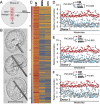Capture and metabolomic analysis of the human endometrial epithelial organoid secretome
- PMID: 33876774
- PMCID: PMC8053979
- DOI: 10.1073/pnas.2026804118
Capture and metabolomic analysis of the human endometrial epithelial organoid secretome
Abstract
Suboptimal uterine fluid (UF) composition can lead to pregnancy loss and likely contributes to offspring susceptibility to chronic adult-onset disorders. However, our understanding of the biochemical composition and mechanisms underpinning UF formation and regulation remain elusive, particularly in humans. To address this challenge, we developed a high-throughput method for intraorganoid fluid (IOF) isolation from human endometrial epithelial organoids. The IOF is biochemically distinct to the extraorganoid fluid (EOF) and cell culture medium as evidenced by the exclusive presence of 17 metabolites in IOF. Similarly, 69 metabolites were unique to EOF, showing asymmetrical apical and basolateral secretion by the in vitro endometrial epithelium, in a manner resembling that observed in vivo. Contrasting the quantitative metabolomic profiles of IOF and EOF revealed donor-specific biochemical signatures of organoids. Subsequent RNA sequencing of these organoids from which IOF and EOF were derived established the capacity to readily perform organoid multiomics in tandem, and suggests that transcriptomic regulation underpins the observed secretory asymmetry. In summary, these data provided by modeling uterine luminal and basolateral fluid formation in vitro offer scope to better understand UF composition and regulation with potential impacts on female fertility and offspring well-being.
Keywords: endometrium; human; organoid; reproduction; uterine fluid.
Conflict of interest statement
The authors declare no competing interest.
Figures





Similar articles
-
Infertile human endometrial organoid apical protein secretions are dysregulated and impair trophoblast progenitor cell adhesion.Front Endocrinol (Lausanne). 2022 Dec 14;13:1067648. doi: 10.3389/fendo.2022.1067648. eCollection 2022. Front Endocrinol (Lausanne). 2022. PMID: 36589798 Free PMC article.
-
Integrated MicroRNA and Secretome Analysis of Human Endometrial Organoids Reveal the miR-3194-5p/Aquaporin/S100A9 Module in Regulating Trophoblast Functions.Mol Cell Proteomics. 2023 Apr;22(4):100526. doi: 10.1016/j.mcpro.2023.100526. Epub 2023 Mar 7. Mol Cell Proteomics. 2023. PMID: 36889440 Free PMC article.
-
From cup to dish: how to make and use endometrial organoid and stromal cultures derived from menstrual fluid.Front Endocrinol (Lausanne). 2023 Sep 21;14:1220622. doi: 10.3389/fendo.2023.1220622. eCollection 2023. Front Endocrinol (Lausanne). 2023. PMID: 37810883 Free PMC article.
-
Using organoids to investigate human endometrial receptivity.Front Endocrinol (Lausanne). 2023 Aug 24;14:1158515. doi: 10.3389/fendo.2023.1158515. eCollection 2023. Front Endocrinol (Lausanne). 2023. PMID: 37693361 Free PMC article. Review.
-
Endometrial Organoids: A Rising Star for Research on Endometrial Development and Associated Diseases.Reprod Sci. 2021 Jun;28(6):1626-1636. doi: 10.1007/s43032-021-00471-z. Epub 2021 Feb 2. Reprod Sci. 2021. PMID: 33533008 Review.
Cited by
-
Equine Oviductal Organoid Generation and Cryopreservation.Methods Protoc. 2022 Jun 15;5(3):51. doi: 10.3390/mps5030051. Methods Protoc. 2022. PMID: 35736552 Free PMC article.
-
The human placenta: new perspectives on its formation and function during early pregnancy.Proc Biol Sci. 2023 Apr 26;290(1997):20230191. doi: 10.1098/rspb.2023.0191. Epub 2023 Apr 19. Proc Biol Sci. 2023. PMID: 37072047 Free PMC article.
-
Multi-omics analysis of uterine fluid extracellular vesicles reveals a resemblance with endometrial tissue across the menstrual cycle: biological and translational insights.Hum Reprod Open. 2025 Feb 24;2025(2):hoaf010. doi: 10.1093/hropen/hoaf010. eCollection 2025. Hum Reprod Open. 2025. PMID: 40084293 Free PMC article.
-
The Roles of Extracellular Vesicles and Organoid Models in Female Reproductive Physiology.Int J Mol Sci. 2022 Mar 16;23(6):3186. doi: 10.3390/ijms23063186. Int J Mol Sci. 2022. PMID: 35328607 Free PMC article. Review.
-
The embryo culture media in the era of epigenetics: is it time to go back to nature?Anim Reprod. 2022 Apr 20;19(1):e20210132. doi: 10.1590/1984-3143-AR2021-0132. eCollection 2022. Anim Reprod. 2022. PMID: 35493788 Free PMC article. Review.
References
-
- Salamonsen L. A., Evans J., Nguyen H. P. T., Edgell T. A., The microenvironment of human implantation: Determinant of reproductive success. Am. J. Reprod. Immunol. 75, 218–225 (2016). - PubMed
-
- Burton G. J., Watson A. L., Hempstock J., Skepper J. N., Jauniaux E., Uterine glands provide histiotrophic nutrition for the human fetus during the first trimester of pregnancy. J. Clin. Endocrinol. Metab. 87, 2954–2959 (2002). - PubMed
-
- Spencer T. E., Kelleher A. M., Bartol F. F., Development and function of uterine glands in domestic animals. Annu. Rev. Anim. Biosci. 7, 125–147 (2019). - PubMed
Publication types
MeSH terms
Grants and funding
LinkOut - more resources
Full Text Sources
Other Literature Sources
Molecular Biology Databases

